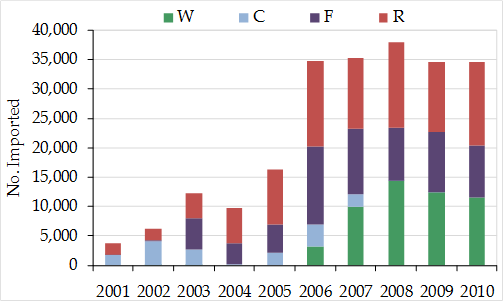Criteria met: High volume (globally threatened), overall increase
Principal trade term to the EU: live
Percentage of global trade to the EU: 59%
Principal source: ranched, wild
Top EU importer: Italy, United Kingdom
Top Trading Partner: Uzbekistan
CITES Appendix: II
IUCN Status: Vulnerable

EU-reported imports of live Testudo horsfieldii from the three main sources (‘W’, ‘C’, ‘F’ and ‘R’; ‘W’ includes ‘U’), all purposes, 2001-2010.
In 2010, EU imports principally consisted of live animals traded for commercial purposes (34,557 animals), of which 41% were ranched, 34% were wild and 26% were captive-born.
Although T. horsfieldii met the ‘overall increase’ criterion, total live imports remained relatively constant between 2009 and 2010 and decreased the previous year; ranched imports increased by 19% between 2009 and 2010.
In 2010, all ranched and wild-sourced imports originated in Uzbekistan, while the vast majority of captive-born imports originated in Ukraine.
A long-standing import suspension for wild specimens of this species from all countries of origin was removed on 30/04/2004 and trade in wild specimens resumed in 2006. The SRG formed a positive opinion for wild specimens from Uzbekistan on 26/09/2006, which was confirmed on 14/09/2010; a positive opinion was also formed for source ‘F’ and ‘R’ specimens from Uzbekistan with a plastron length of 6-8 cm on 26/03/2001, which was confirmed for ranched specimens (no size limits) on 14/09/2010. The species was selected under the CITES Review of Significant Trade following CoP14 at the 23rd meeting of the Animals Committee; at the 25th meeting of the Animals Committee, Uzbekistan was categorised as of Possible Concern. Based on information communicated by Uzbekistan to the Secretariat on 06/12/2011, the population of Uzbekistan was removed from the review.

